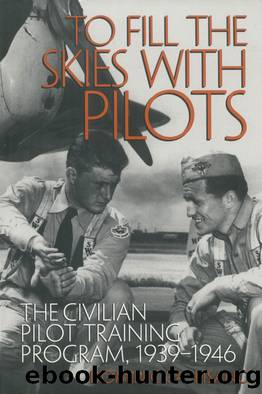To Fill the Skies with Pilots by Dominick A. Pisano

Author:Dominick A. Pisano [Pisano, Dominick A.]
Language: eng
Format: epub
ISBN: 978-1-935623-53-3
Publisher: Smithsonian
Published: 2014-06-03T00:00:00+00:00
The Changing of the Guard
At about the time that the AAF and CAA had reached an accord on the use of the CPTP, other changes were about to take place that would profoundly affect the program for the remainder of its history. Its New Deal foundations had begun to give way to wartime emergency planning, and a new cast of characters was about to take control.
The CPTPâs originator, Robert Hinckley, had played little or no part in the deliberations between the CAA and the AAF. He preferred instead to let Charles Stanton assume the responsibility while he publicly defended the CPTP and promoted his idea of air age education. Hinckleyâs deferral to Stanton was out of character. He had always viewed himself as a public servant and a team player, although he sometimes walked a fine line between invoking the wrath of the aviation community for an unpopular, politically motivated decision or incurring F.D.R.âs displeasure at his unwillingness to go along with White House aviation policy.
But Hinckley had become demoralized by the controversy over the CPTP and the capriciousness of the AAF. Criticism of the CPTP and the failure of the AAF to make better use of the program were evidently the final blows. On June 20, 1942, the New York Times quoted Hinckley, in a speech before the National Aeronautic Association, as saying, âIt sometimes happens that a government agency becomes so strong that it loses touch with the people who really own it, and it begins to fight not for the people but for itself.â According to the Timesâs account, Hinckley âdenied that he had the War Department in mind,â but there was no question that he referred to the air forceâs obstinacy about the CAA and the CPTP.33
This was to be Hinckleyâs parting shot. A few days later, he resigned as assistant secretary of commerce, effective July 1, to become assistant to the president of the Sperry Corporation. In his letter of resignation, he stressed how difficult his decision had been because âthe progress of civil aviation has become almost an obsession with me.⦠It is only because I am to undertake work of great importance in the war production program which is so closely related to aviation that I do so.â34
Reaction to Hinckleyâs departure was predictable; the usual valedictory accolades cited his invaluable contributions to aviation. F.D.R. accepted the resignation âwith extreme reluctanceâ and praised him for his accomplishments and contributing âa decided emphasis on the creative and developmental as contrasted with the purely regulatory aspects of aviation.â The New York Times applauded Hinckleyâs âbroad vision and devoted interest in the âair conditioningâ⦠of America.â35
The tone of the Aero Digestâs editorial, however, was bitter. âMuch can be read between the lines in the resignation of Robert H. Hinckley,â it said. âThe net result, however, is that aviation loses a Washington representative who has been instrumental in the training of 80,000 civilian pilots, of which number 34,000 are now in the Air Force.⦠But the brass hat
Download
This site does not store any files on its server. We only index and link to content provided by other sites. Please contact the content providers to delete copyright contents if any and email us, we'll remove relevant links or contents immediately.
| Airport | Commercial |
| Helicopters | History |
| Pictorial | Piloting & Flight Instruction |
| Repair & Maintenance |
Small Unmanned Fixed-wing Aircraft Design by Andrew J. Keane Andras Sobester James P. Scanlan & András Sóbester & James P. Scanlan(32137)
Navigation and Map Reading by K Andrew(4550)
Endurance: Shackleton's Incredible Voyage by Alfred Lansing(3834)
Wild Ride by Adam Lashinsky(1655)
And the Band Played On by Randy Shilts(1612)
The Box by Marc Levinson(1591)
Top 10 Prague (EYEWITNESS TOP 10 TRAVEL GUIDES) by DK(1563)
The Race for Hitler's X-Planes: Britain's 1945 Mission to Capture Secret Luftwaffe Technology by John Christopher(1523)
The One Percenter Encyclopedia by Bill Hayes(1461)
Girls Auto Clinic Glove Box Guide by Patrice Banks(1357)
Trans-Siberian Railway by Lonely Planet(1337)
Looking for a Ship by John McPhee(1316)
Fighting Hitler's Jets: The Extraordinary Story of the American Airmen Who Beat the Luftwaffe and Defeated Nazi Germany by Robert F. Dorr(1299)
Batavia's Graveyard by Mike Dash(1298)
Troubleshooting and Repair of Diesel Engines by Paul Dempsey(1280)
Bligh by Rob Mundle(1269)
TWA 800 by Jack Cashill(1249)
The Great Halifax Explosion by John U. Bacon(1227)
Ticket to Ride by Tom Chesshyre(1224)
